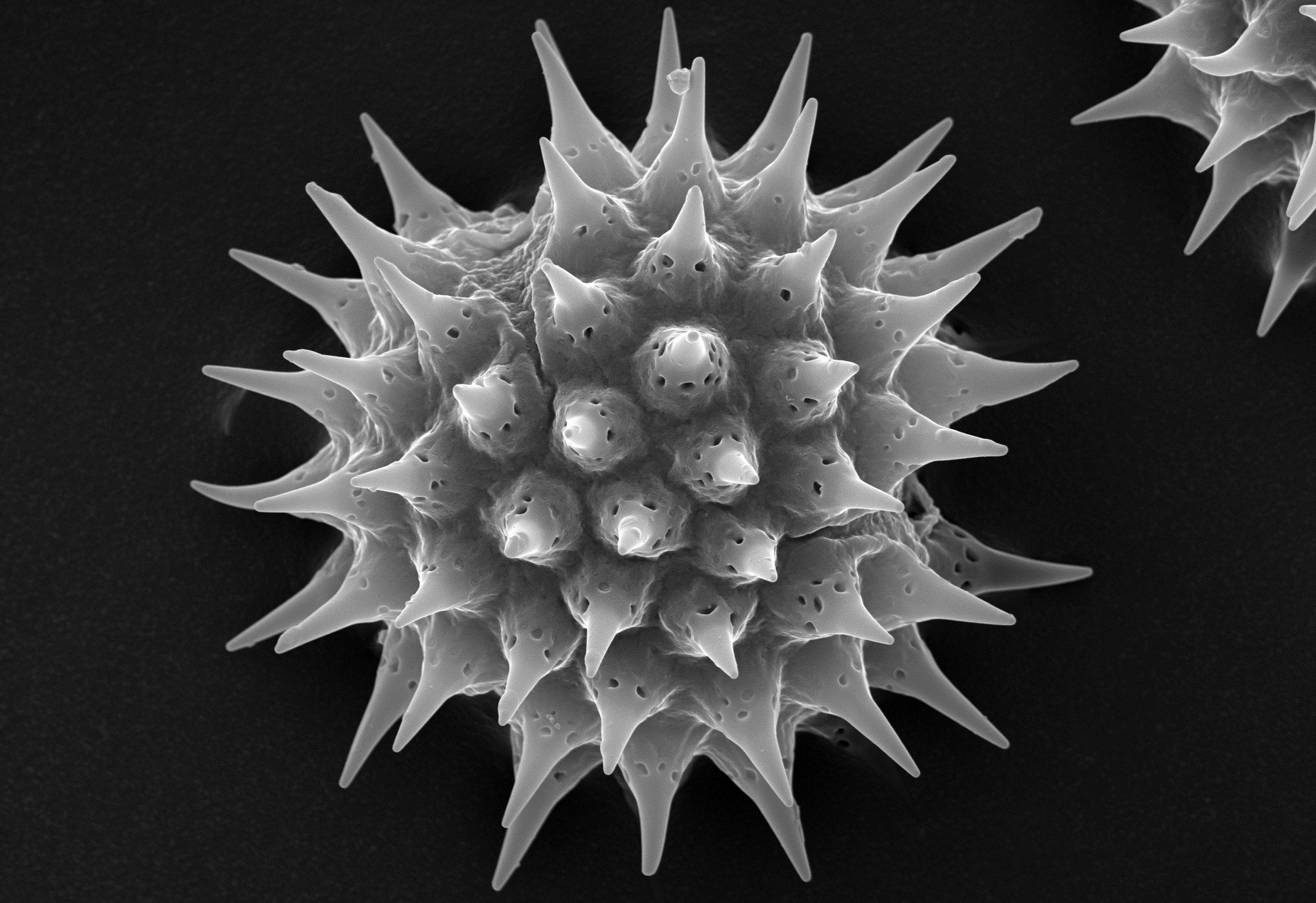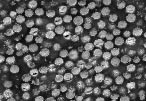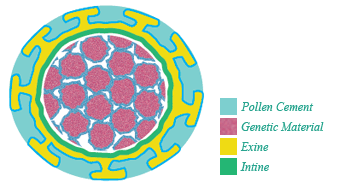Spores and Pollens
Definition
Pollen – grains containing the male reproductive cells of most plants. They are the male gametophyte generation of seed bearing plants and borne by the anther in a flowering plant. They are often twin celled.
Spores – are small usually single-celled asexual reproductive grains produced by many nonflowering plants and fungi and some bacteria and protozoans. They are capable of developing into new adults without sexual fusion.
Size and Shape
Each spore or pollen particle has a size and shape specific to the plant, fungi or bacteria from which it originated. This has led to spore identification being widely used in forensic science. Four spores with very different sizes and shapes are illustrated below.
Lycopodium clavatum (25 µm)
Helianthus annuus (20 um diameter with 30 um spike to spike diameter)

Ambrosia trifida (15 µm)

Aspergilus niger (4 µm)

The range in mean diameter is large, ranging from about 2 µm to more than 200 µm. The particle size of some typical spores and pollens are given in the table below. The spores and pollens we currently work with are highlighted.
| Myosotis (“forget-me-not”) | 2.4 – 5 µm |
| Aspergillus niger | 4 µm |
| Penicillium | 3 – 5 µm |
| Cantharellus minor | 4 – 6 µm |
| Ganomerma | 5 – 6.5 µm |
| Chlorella Vulgaris |
8 - 10 µm |
| Oilseed rape | 10 - 12 µm |
| Agrocybe | 10 – 14 µm |
| Urtica dioica | 10 – 12 µm |
| Periconia | 16 – 18 µm |
| Epicoccum | 20 µm |
| Helianthus annuus | 20 um |
| Ryegrass | 21 µm |
| Timothy grass | 22 µm |
| Rye | 22 µm |
| Lycopodium clavatum | 25 µm |
| “Lycopodium powder” | 40 µm |
| Rye grass | 40 µm |
| Pine | 50 µm |
| Maize | 80 µm |
| Hemp | 24 µm |
| Rape hemp | 25 µm |
| Wheat | 23 µm |
| Abies | 125 µm |
| Cucurbitapapo | 200 µm |
| Cuburbita | 250 µm |
The pollen / spores from each source are exactly the same size i.e. monodispersed. This can be seen for Lycopodium clavatum in the scanning electron microscope pictures shown here.
This graph shows actual measurements of particles dispersed in air and measured using a light scattering instrument.
The actual distribution is narrower than the measured one, because the particles are not spherical and so do not have a single diameter. They can also align themselves in different directions within the detection beam. In addition the instrument software is designed to measure particles with a normal or lognormal distribution, not monodispersed as happens here.
Structure
From the point of view of Sporomex technology the skeleton walls of pollens and spores are similar. The centre of the particle contains the generic material. This can be viewed using confocal laser scanning microscopy.
Click here to view a confocal microscope picture of raw Lycopodium clavatum spores showing the contents of the spores required for plant reproduction
Surrounding this is a skeleton shell composed of an exine and an intine.
The exine A, is composed of nexine and sexine. The cavities of the sexine are filled with pollen cement. The exine consists mainly of sporopollenin while the intine's main component is cellulose.

This is porous and holes can be seen on the surface of some types, for example Ambrosia trifida.
Click here to view a scanning electron microscope picture of an Ambrosia trifida particle
This is the basis of Sporomex technology as it enables the genetic material to be removed and the remaining shell to be refilled with an active ingredient.
Physical Properties
Spore and pollen particles are elastic and able to withstand many tonnes of pressure. Their shells can withstand acidic and alkali environments, but can be destroyed by high oxidation or in the blood within the human body. They will withstand temperatures of more than 250 oC and are so stable that they are found in igneous rocks.
Availability
The purchase price will depend upon the amount required and the species. Lycopodium clavatum has been used in many Sporomex studies as it is readily available in multi-tonne quantities as it has other uses such as pyrotechnics in shows and film productions. Others such as Ambrosia trifida are much more expensive and limited in supply. Small spores such as Chlorella and Aspirgillus niger can be grown in tanks on a commercial scale.
The picture below is of large scale harvesting of rye pollen at Allergon Sweden.
